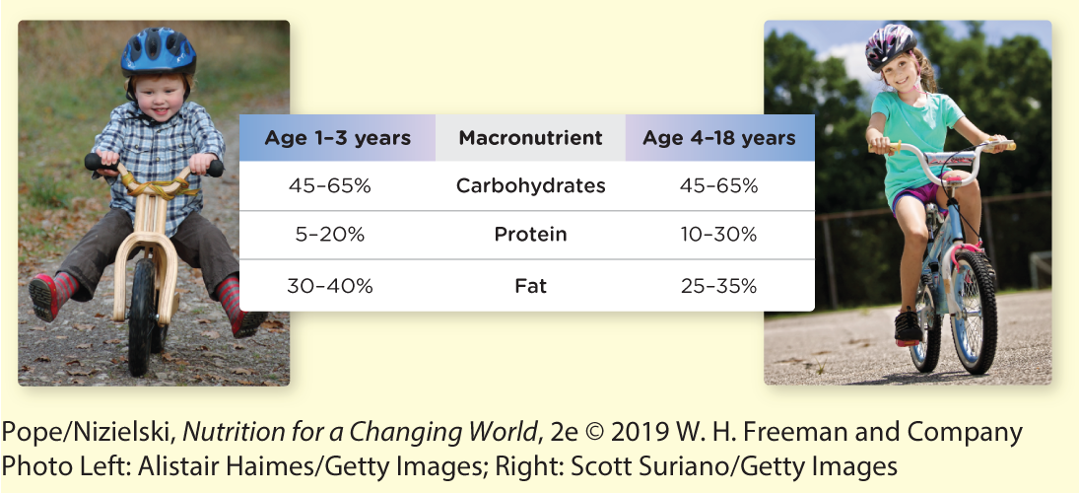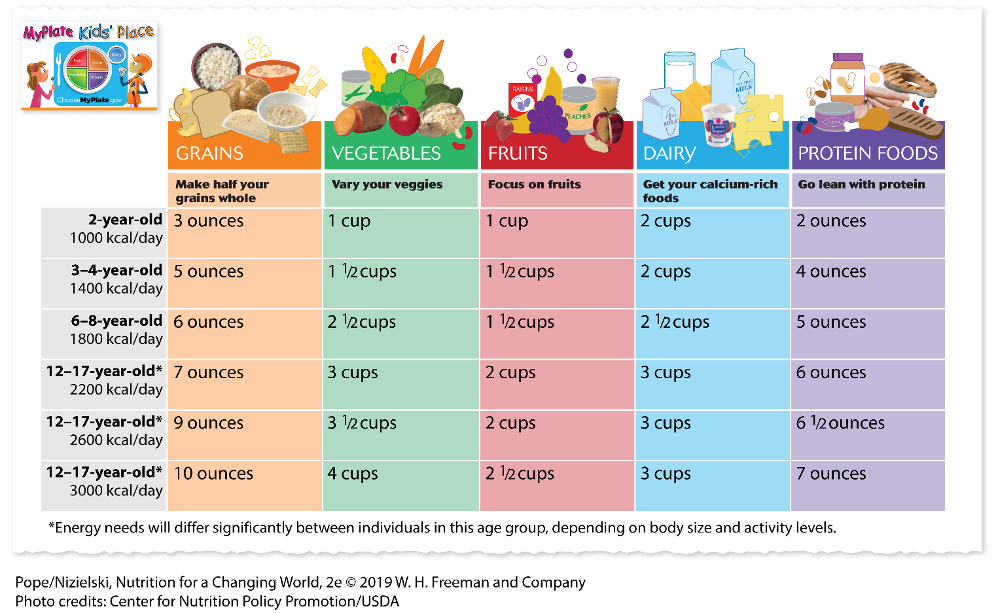Spotlight F: Childhood nutrition
The hygiene hypothesis
- Reduced exposure to childhood infections in developed countries can help explain drastic increases in rates of allergies and other immune disorders, such as asthma
Growth chart
age appropriate growth rates of adequate nutrition
CDC growth charts serve as reference to comparison
Weight or height at or under 5th percentile for his/her age is at risk for undernutrition
85th or 95th percentile of BMI-for-age are at risk of being overweight and obese, respectively

Growth in early childhood
Growth slows in preschool children aged 2-5 years after the rapid growth during infancy
Average increases
- Weight ↑ 4.5-6.6 pounds per year
- Height ↑ 3-4 inches per year
Growth in School-aged Children
Children vary in height, weight, and build during the school years due to genetics, nutrition, and exercise patterns
Age 6-11
- Growth spurts
- Periods of accelerated physical development
- Weight ↑ 6.5 pounds/year on average
- Height ↑ 2+ inches/year on average
Growth during Puberty
~50% of adult body weight is gained during puberty
Boys
- Typically begins at age 12 or 13
- Average gain of ~2.5 inches in height and 11+ pounds in weight a year for a span of about 4 years
Girls
- Typically begins at age 10 or 11
- Average gain of ~2 inches in height and ~9 pounds in fat and lean mass a year
Diets of children in the U. S. are typically
↑energy-density
↓nutrient-density
↓fiber
↓vegetables
↓greens and beans
↓whole grains
↓plant proteins
added sugars account for approximately 40% of total calorie intake in 2- to 18-year-olds
children eat poorly because they More meals away from home and
Drink less milk and more soft drinks
National school lunch program
Federally assisted program that provides nutritionally balanced, low-cost or free meals to children each school day
2010 Healthy, Hunger-Free Kids Act
USDA issued new standards in 2012 to ensure meals align with Dietary Guidelines for Americans
AMDRs for Children
healthful ranges of macronutrient intake for growth and development


Children as young as 2 should control the quantity of food consumed to avoid excess intake and habitual overeating
Physical activity
U.S. Department of Health and Human Services (HHS) recommend children and adolescents older than 6 years engage in:
60 minutes or more of physical activity per day
Health benefits
Lower risk excessive weight gain, Improved bone health and weight status Improved cognitive function, Improved quality of sleep, Reduced symptoms depression and anxiety, Lower activity associated with lower diet quality
nutrients concern
Calcium
Important for bone health and optimizing bone mass
Iron
Supports growth and prevents iron-deficiency anemia
Replaces iron lost through menstruation in adolescent girls
Fiber
Alleviates constipation
Shown to reduce the risk of chronic diseases
Vitamin D
Crucial for skeletal health and optimal bone development
Healthcare providers may recommend supplementation as intake recommendation recently increased by 50%
Childhood Obesity and Disease
Approximately 17% of American children and adolescents aged 2–19 are currently obese Obese children are at increased risk for multiple physical and psychological problems:
(High blood pressure, High cholesterol, Type 2 diabetes, Asthma Joint problems, Fatty liver disease, Psychological problems, Bullying and negative stereotyping, Obesity as adults)
Overweight and obese children are at an increased risk of becoming obese as adults
Energy-dense foods, larger portion sizes, more meals away from home
preventing obesity
National, state, and private programs are working to reduce and prevent the prevalence of childhood obesity
Food allergy is a reproducible, adverse reaction to a food caused an immune response to an allergen in that food
The number of people with food allergies is growing without a clear reason why
process: sensation allergic reaction symptom
CDC lists eight foods that cause 90% of allergic reactions
For those allergic to one or more foods, consuming even minute amounts can be immediately life-threatening
Reproducible adverse reaction to a food that is not a direct result of an antibody (IgE)-dependent immune response
Can induce allergy-like gastrointestinal and respiratory symptoms
Not life-threatening and result from different bodily mechanisms
ex: lactose intolerance & celiac disease
No “cure” for allergies
Avoid allergen
Food Allergen Labeling and Consumer Protection Act of 2004
Manufacturers must declare the presence of major food allergens on food packages
Avoiding common allergens such as fish, eggs, and peanuts during pregnancy, breastfeeding, or beyond 4‒6 months of age does not seem to be protective
2017 new guidelines issued advising early introduction of foods containing peanuts to infants to reduce risk of peanut allergy
LEAP study showed that introducing peanut-containing foods to infants at high risk of the allergy was safe and led to an 81% reduction in subsequent peanut allergy